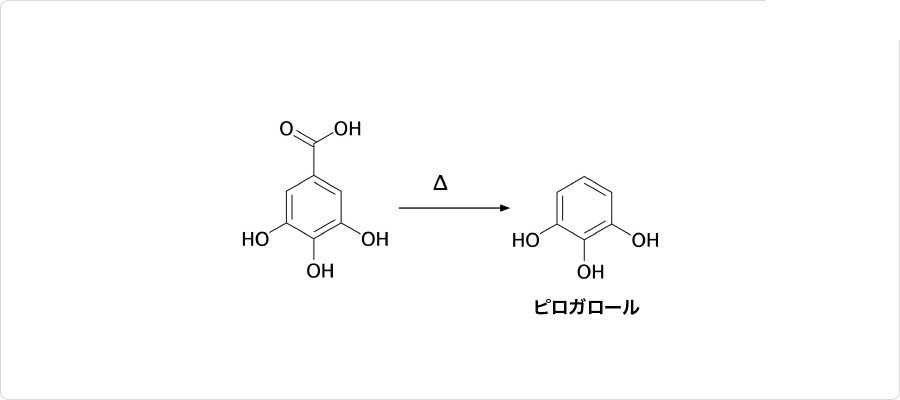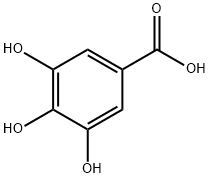-
種類
没食子酸は主に研究開発用試薬製品や、産業用化成品として販売されています。研究開発用試薬は、有機合成原料や生物化学実験などの分野で用いられる物質です。
容量の種類には10 g , 250g , 1kgなどがあります。常温保存可能な試薬として扱われます。また、没食子酸は一水和物が安定に存在することから、一水和物も試薬製品として販売されている物質です。
産業用化成品としては、一般工業用途、電子材料や食品添加物などの用途で販売されています。15kgや25kgなど工場での汎用性が高い大容量での提供が一般的です。
-
定義
本品は、次の化学式で表される有機酸である。
-
性質

図2. 没食子酸の脱炭酸反応
没食子酸は、水に溶けると、アルカリ性水溶液となる物質です。没食子酸のアルカリ性水溶液は、還元力が強く、空気中の酸素によって容易に酸化されます。また、没食子酸の接触水素化還元では、芳香環が還元されてシクロヘキサン環誘導体を与えます。
没食子酸を加熱すると、脱炭酸によってカルボキシル基が除去されます。この反応の生成物がピロガロールです。ピロガロールは、焦性没食子酸という別名を持ち、有機合成試薬、写真の現像液、毛織物の媒染剤、染料の成分などとして活用されている物質です。
没食子酸は吸湿性があることから、一水和物が安定に存在します。没食子酸一水和物は、1分子の結晶水を含んでいますが、融点に達すると分解し、ピロガロールとが生成されます。
-
解説
没食子酸は,芳香族ヒドロキシカルボン酸の一つ。「もっしょくしさん」ともいわれる。別名はピロガロール-5-カルボン酸、3,4,5-トリヒドロキシ安息香酸。分子式C7H6O5、分子量188.1。無水物は融点235~240 ℃ で,融解と同時にピロガロールと二酸化炭素に分解する.熱水,エタノール,アセトンに易溶.アルカリ性水溶液は還元力が強く,空気中からすみやかに酸素を吸収する.植物の葉、茎、根、および没食子、五倍子(ごばいし)の虫こぶなどに遊離の状態またはタンニンの構成成分として分布している。 没食子・茶・五倍子や広く植物の根・茎・葉・果実などに含まれ、タンニンを加水分解して得られる無色針状の結晶。渋味・収斂(しゅうれん)性があり、還元性が強い。医薬のほかインク・染料・写真現像剤などに用いられる。ぼっしょくしさん。没食子はブナ科植物の若芽のモッショクシバチによる虫こぶから、五倍子はウルシ科植物ヌルデの若芽や葉のアブラムシによる虫こぶから得られ、乾物として漢方薬などに使われている。タンニンを加水分解して得られる無色の柱状結晶で、1分子の結晶水を含むが120℃付近で結晶水を失う。融点(258~265℃)において分解し、ピロガロールと二酸化炭素になる(図)。水によく溶け、鉄(Ⅲ)塩水溶液を加えると青黒色の沈殿を生ずる。強力な還元剤である。タンニンの原料、青インキの製造に使われるほか、写真現像剤、染料の原料、止血剤としての用途ももつ。[廣田 穰 2016年2月17日][参照項目] | タンニン | ヒドロキシカルボン酸 | ピロガロール  "没食子酸の反応〔図〕
"没食子酸の反応〔図〕
小学館 日本大百科全書(ニッポニカ) )
-
用途
油脂の酸化防止剤、インキ原料
-
化粧品の成分用途
収れん剤
-
合成
没食子酸の生合成
没食子酸は、五倍子 (ヌルデの虫こぶ) 、没食子 (中近東のブナ・カシワの虫こぶ) 、マンサク科の植物ハマメリス、茶の葉、オークの樹皮など、多くの植物に含まれている物質です。加水分解性タンニンの基本骨格を成しています。
自然界における生合成では、まずシキミ酸デヒドロゲナーゼの働きによって、3-デヒドロシキミ酸から3,5-ジデヒドロシキミ酸が合成されます。没食子酸は、この中間体物質の芳香環化によって合成されている物質です。
-
説明
Gallic acid is a trihydroxybenzoic acid, a type of phenolic acid, a type of organic acid, also known as 3,4,5- trihydroxy benzoic acid, found in gallnuts, sumac, witch hazel, tea leaves, oak bark, and other plants. The chemical formula is C6H2(OH)3COOH. Gallic acid is found both free and as part of hydrolyzable tannins.
Salts and esters of gallic acid are termed 'gallates'. Despite its name, it does not contain gallium.
Gallic acid is commonly used in the pharmaceutical industry. It is used as a standard for determining the phenol content of various analytes by the Folin - Ciocalteau assay; results are reported in gallic acid equivalents. Gallic acid can also be used as a starting material in the synthesis of the psychedelic alkaloid mescaline.
Gallic acid seems to have anti-fungal and antiviral properties. Gallic acid acts as an antioxidant and helps to protect human cells against oxidative damage. Gallic acid was found to show cytotoxicity against cancer cells, without harming healthy cells. Gallic acid is used as a remote astringent in cases of internal haemorrhage. Gallic acid is also used to treat albuminuria and diabetes. Some ointments to treat psoriasis and external haemorrhoids contain gallic acid.
-
化学的特性
Gallic acid, also known as trihydroxybenzoic acid, is a colorless crystalline needles or prisms that is obtained from nutgall tannins. It is soluble in hot water, ether, ethanol, acetone and glycerin, insoluble in cold water, insoluble in benzene and chloroform and has a melting point of 235 to 240 °C (decomposition). When heated to 100-120°C, crystal water will be lost, and when heated above 200°C, carbon dioxide will be lost to generate pyrogallic acid (ie, pyrogallol). It is used in photography, tanning, ink manufacture and pharmaceuticals.
-
天然物の起源
Gallic acid is found in a number of land plants. It is also found in the aquatic plant Myriophyllum spicatum and shows an allelopathic effect on the growth of the blue-green alga Microcystis aeruginosa.
In food
Areca nut
Bearberry (Arctostaphylos sp)
Bergenia sp
Blackberry
Hot chocolate
Juglans regia (Common walnut)
Mango in peels and leaves
Phyllanthus emblica (Indian gooseberry) in fruits
Raspberry
Syzygium aromaticum (clove)
Vinegar
wine
Witch hazel (Hamamelis virginiana)
White tea.
-
来歴
Gallic acid is an important component of iron gall ink, the standard European writing and drawing ink from the 12 th to 19th century with a history extending to the Roman empire and the Dead Sea Scrolls. Pliny the Elder (23-79 AD) describes his experiments with it and writes that it was used to produce dyes. Galls (also known as oak apples) from oak trees were crushed and mixed with water, producing tannic acid (a macromolecular complex containing gallic acid). It could then be mixed with green vitriol (ferrous sulfate) — obtained by allowing sulfate - saturated water from a spring or mine drainage to evaporate — and gum arabic from acacia trees; this combination of ingredients produced the ink.
Gallic acid was one of the substances used by Angelo Mai (1782–1854), among other early investigators of palimpsests, to clear the top layer of text off and reveal hidden manuscripts underneath. Mai was the first to employ it, but did so "with a heavy hand", often rendering manuscripts too damaged for subsequent study by other researchers.
Early photographers, including Joseph Bancroft Reade (1801– 1870) and William Fox Talbot (1800 – 1877), used gallic acid for developing latent images in calotypes. It has also been used as a coating agent in zincography.
-
使用
gallic acid is a potential bleaching agent and anti-oxidant, it is also astringent and potentially anti-microbial and anti-fungal. Scientists are finding that gallic acid may serve as a skin-lightening agent by inhibiting the action of the tyrosinase and peroxidase enzymes. Some studies indicate that it is more effective than hydroquinone when combined with the proper ingredients. It is also incorporated into anti-aging formulations for its ability to prevent mucopolysaccaride deterioration. It is a constituent of witch hazel and oak bark, among many other plants; however, it is generally obtained from nutgalls for commercial purposes.
-
調製方法
Gallic acid, a component of many tanning agents is an endogenous product in plants. The acid occurs free or bound to tannin [1401-55-4] (e.g., in divi-divi, oak bark, gallnuts, pomegranate roots, sumac, and tea). The acid is produced from tannin-rich aqueous gallnut extracts by acidic or alkaline hydrolysis. It is also obtained by using the enzyme tannase [9025-71- 2] or molds (Penicillium glaucum, Aspergillus niger) to cleave tannin by fermentation. Both the metabolism of gallic acid and its impact on plant growth enzymes have been studied.
-
定義
ChEBI: Gallic acid is a trihydroxybenzoic acid in which the hydroxy groups are at positions 3, 4, and 5. It has a role as an astringent, a cyclooxygenase 2 inhibitor, a plant metabolite, an antioxidant, an antineoplastic agent, a human xenobiotic metabolite, an EC 1.13.11.33 (arachidonate 15-lipoxygenase) inhibitor, an apoptosis inducer and a geroprotector. It is a conjugate acid of a gallate.
-
一般的な説明
Gallic acid is a phenol that has been found in C. sinensis and has diverse biological activities. It scavenges DPPH and hydroxyl radicals in cell-free assays (IC50s = 9.4 and 191 μM, respectively). Gallic acid (1-100 μM) reverses abscisic acid-induced inhibition of hypocotyl growth in A. caudatus seedlings. In vivo, gallic acid (21.8 g/kg) inhibits morpholine- and sodium nitrite-induced adenocarcinoma formation in mice. It also inhibits passive cutaneous anaphylaxis in mice when administered at a dose of 50 mg/kg.
-
空気と水の反応
Sparingly water soluble
-
反応プロフィール
Phenols, such as Gallic acid, do not behave as organic alcohols, as one might guess from the presence of a hydroxyl (-OH) group in their structure. Instead, they react as weak organic acids. Phenols and cresols are much weaker as acids than common carboxylic acids (phenol has Ka = 1.3 x 10^[-10]). These materials are incompatible with strong reducing substances such as hydrides, nitrides, alkali metals, and sulfides. Flammable gas (H2) is often generated, and the heat of the reaction may ignite the gas. Heat is also generated by the acid-base reaction between phenols and bases. Such heating may initiate polymerization of the organic compound. Phenols are sulfonated very readily (for example, by concentrated sulfuric acid at room temperature). The reactions generate heat. Phenols are also nitrated very rapidly, even by dilute nitric acid.
-
健康ハザード
Inhalation of dust may irritate nose and throat. Contact with eyes or skin causes irritation.
-
火災危険
Flash point data for Gallic acid are not available. Gallic acid is probably combustible.
-
使用用途
没食子酸は、還元力が非常に高い物質です。そのため、食品や化粧品、飼料等の酸化防止剤として用いられており、アルカリ性水溶液は、還元剤、写真の現像剤に使われています。
その他の用途は、タンニンの原料や青インキの製造や、染料の原料などです。また、培養工学用試薬や植物生長制御試薬、生長阻害剤などに利用されることもあります。
没食子酸は、多くの誘導体が合成されており、さまざまな分野で活用されている物質です。例えば、没食子酸プロピル、没食子酸イソアミルなどのエステルは、油脂・バターの酸化防止剤にも使用されます。
カテキンの一種、エピガロカテキンガラートも没食子酸のエステルです。これらの誘導体の一部は、工業薬品や電子材料製造薬品などにも応用されており、医薬品分野においては、収斂剤や喀血のとして用いられています。
-
副作用
It is a weak carbonic anhydrase inhibitor.
-
代謝
Biosynthesis
Chemical structure of 3,5- didehydro shikimate Gallic acid is formed from 3-dehydro shikimate by the action of the enzyme shikimate dehydro genase to produce 3,5-didehydro shikimate. This latter compound tautomerizes to form the redox equivalent gallic acid, where the equilibrium lies essentially entirely toward gallic acid because of the coincidently occurring aromatization.
Degradation
Gallate dioxygenase is an enzyme found in Pseudomonas putida that catalyzes the reaction :
gallate + O2 → (1E)-4-oxobut-1-ene-1,2,4-tri carboxylate.
Gallate decarboxylase is another enzyme in the degradation of gallic acid.
Conjugation
Gallate 1-beta-glucosyltransferase is an enzyme that uses UDPglucose and gallate, whereas its two products are UDP and 1-galloylbeta- D-glucose.
-
純化方法
Crystallise gallic from water. The tri-O-acetyl derivative has m 172o (from MeOH), and the anilide has m 207o(from EtOH). [Beilstein 10 H 470, 10 IV 1993.]
-
参考文献
Plant polyphenols (vegetable tannins): gallic acid metabolism. DOI:10.1039/NP9941100041
Biotechnology of Food and Feed Additives DOI:10.1007/978-3-662-43761-2
Purification of Laboratory Chemicals DOI:10.5860/choice.50-6768
Gallic acid: a versatile antioxidant with promising therapeutic and industrial applications DOI:10.1039/C5RA01911G
Antioxidant properties and total phenolics content of green and black tea under different brewing conditions DOI:10.1007/S002170050406
Comparative study of eight well‐known polyphenolic antioxidants DOI:10.1211/0022357021693
Antagonistic Action of Phenolic Compounds on Abscisic Acid-Induced Inhibition of Hypocotyl Growth DOI:10.1093/JXB/31.6.1651



 "没食子酸の反応〔図〕
"没食子酸の反応〔図〕